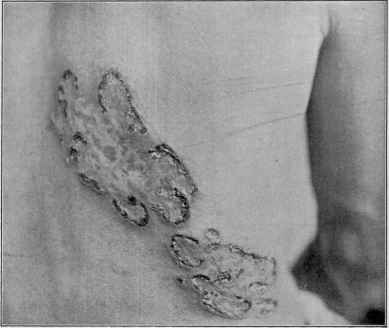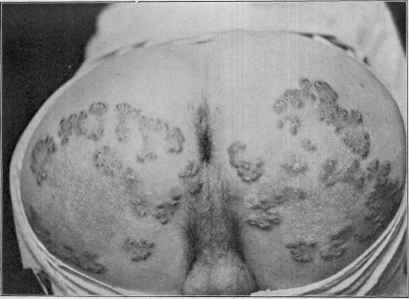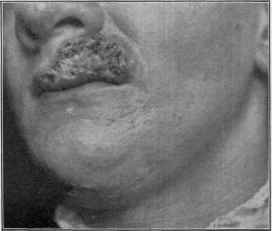| MEDICAL INTRO |
| BOOKS ON OLD MEDICAL TREATMENTS AND REMEDIES |
THE PRACTICAL |
ALCOHOL AND THE HUMAN BODY In fact alcohol was known to be a poison, and considered quite dangerous. Something modern medicine now agrees with. This was known circa 1907. A very impressive scientific book on the subject. |
DISEASES OF THE SKIN is a massive book on skin diseases from 1914. Don't be feint hearted though, it's loaded with photos that I found disturbing. |
Gummatous Syphiloderm (Synonyms: Syphiloderma gumma-
tosum; Gumma; Syphiloma; Syphilis cutanea gummatosa).—Thegumma-
tous manifestation is usually a late tertiary formation. It does sometimes
occur in the secondary stage and exceptionally at an early period (syphilis
præcox), and is then to be looked upon as probably indicating a malig
nant grade of syphilis, and in such instances may be present in greater
number than late in the disease. Generally, however, it shows itself
as one or several painless or slightly painful, rounded or flattened, more
or less circumscribed tumors, moderately projecting, at first firm, and
having their seat in the subcutaneous tissue. In its earliest beginning
it can be felt as a pea-sized deposit or infiltration, and may grow slowly
or rapidly, taking one or two weeks to several months before reaching
full development. As it increases in size the overlying skin is slightly
stretched, and changes from the normal color to a dull pinkish or pinkish-
red tint, which later, with increased growth, assumes a dusky or dark-
red color. When fully developed, it may be the size of a walnut or much
larger, and be considerably elevated. While firm at first, it soon, as it
grows in size, becomes soft and doughy, and later tends to break down
and ulcerate. It may even, when well advanced, disappear by ab-
810
NEW GROWTHS
sorption, but usually it gradually or rapidly breaks down, the skin
giving way, at first centrally and then extending or at several points,
and resulting in a small or large, deep, punched-out ulcer, with, as a
rule, free gummy puriform secretion, which may later assume a greenish
tinge and have an offensive odor.
In other instances, instead of a tolerably well-circumscribed, grow
ing subcutaneous nodule, the gummatous infiltration is more diffuse,
involving a palm-sized or large area and without being at all sharply
defined peripherally; but the central portion is sometimes considerably
elevated, and there is a gradual sloping into the surrounding part; the
skin is at first usually pinkish, with a sluggish, violaceous tinge, later

Fig. 198.—Tubercular syphiloderm. with decided ulceration, showing a rare zosteriform
distribution (courtesy of Dr. M. B. Hartzell).
becoming dull reddish. It may be less diffused in the beginning and then
spread out, or it may start as a large area. The infiltration gradually
or rapidly becomes more marked, and the skin and tissue break down,
either at scattered points or the destructive process involves the whole
plaque uniformly; there results, therefore, either a dull reddish or viola
ceous, somewhat elevated, or later flattened area, beset with several
or more bean- to nut-sized, sharply cut or punched-out ulcers, which
may be irregularly disposed or exhibit segmental or serpiginous configu
ration, with more or less gummy purulent discharge, and which may at
times dry to thickish, brownish or greenish crusts; or one extremely
large, scooped-out, often deep-set open ulcer with edges well defined,
sometimes slightly sloping, sometimes sharply cut. In occasional in-
Plate XXVIII.
Gummatous syphiloderm, showing diffused gummatous infiltration, with characteristic
ulcers and scarring from former lesions.
SYPHILIS
811
stances the infiltration is more superficial and but slightly elevated,
having the dull, sluggishly inflammatory aspect, and at first has an acute
or subacute eczematoid appearance, soon giving way here and there
to superficial ulceration; or the destructive process involves the entire
area, and may later, as in other forms of gummatous infiltration, extend
somewhat deeply.
Sometimes the plaque begins similarly to that just described, but
is the seat of closely set or crowded tubercles or small gummata, lesions
partaking of both the nature of tubercles and gummata, occasionally
producing considerable enlargement of the part, constituting a type
which is sometimes designated tuberculogummatous syphiloderm or
syphilid or infiltration. When involving the foot and lower part of the
leg, it presents a pseudo-elephantiasic aspect, which might be mistaken

Fig. 199.—Tubercular syphiloderm of several years’ duration, and in an unusual region.
for both elephantiasis and carcinomatous disease. In these larger
diffused gummatous infiltrations the ulcers, instead of being irregularly
rounded or ovalish, may be somewhat segmental or crescentic in shape.
Occasionally in a large, infiltrated plaque absorption or slight ulceration
ensues here and there, and the area therefore sometimes presents irregular
grooves, nodular infiltrations, and projections, which may give it a puck
ered aspect. Exceptionally a gumma may be somewhat superficial, not
extending deeply, and be small, hard, and more or less sharply circum
scribed, with or without tendency to soften and break down, and be slug
gish and slow in its course. Such a formation has sometimes been ob
served on the glans penis and other parts, and has doubtless often been
mistaken for a relapsing chancre or induration (chancre redux), or for
the initial lesion of a supposed second infection.
8l2
NEW GROWTHS
The favorite sites for the gummatous manifestation of syphilis are
the soft parts, especially of the thigh and calf regions, and the trunk.
They may occur upon any region, however, and are not uncommon on
the face, flexor aspects of the arms, and other parts. The course of
gumma or gummatous infiltration is usually slow, although at times
developing with rapidity; the ulcers are, as a rule, persistent, and often
grow larger, while the gummatous process is extending and invading the
contiguous tissues. Sometimes the process is deeply and progressively
destructive, involving bone as well as the soft parts, so that not infre
quently, especially when about the face, considerable disfigurement
results. In the tropics a pyogenic or other infection may be added,

Fig. 200.—Tuberculogummatous syphiloderm involving nose and upper lip, with de
structive action; duration eight months; disease contracted some years previously.
usually giving it a more destructive character and making it rebellious
as to treatment; probably furnishing not infrequent examples of the so-
called “tropical ulcer.”
In the various syphilitic ulcerations treatment is commonly followed
by rapid improvement and finally by cure; and considering the amount
of destruction generally observed, the consequent distortion is relatively
slight, ulcers filling up and healing over with not strikingly conspicuous
scar-formation. At times, especially if about the joints, the cicatricial
tissue may exhibit a keloidal tendency, but, as a rule, this is not observed.
The diagnosis of gumma in the earliest stage is sometimes difficult,
as there is a resemblance to furuncle, abscess, enlarged lymphatic glands,
sebaceous, fatty, fibroid, and other tumors, and to erythema induratum.
SYPHILIS 813
A definite conclusion is sometimes reached only by attention to its origin,
course, and behavior, together with the history of the case and the pos
sible presence of other cutaneous lesions or scars of earlier manifestations.
Compared to most of these formations gumma is much more rapid in its
development. The gummatous ulcer is more or less characteristic,
being usually deep, with sharp, punched-out edges, and frequently but
slight bordering infiltration, and has a rather free purulent discharge.
In epithelioma the border is often semitranslucent and roll-like, or beset
with several or more small, pearl-like tubercles or nodules; the ulcer
shows less discharge and exhibits a disposition to bleed easily; and its
progress is generally slow, and its history often materially different
from that of a gumma. The carcinomatous infiltration and nodules
often seen to arise in the skin or scar of the breast following operation
for breast cancer, and which sometimes arise primarily, can readily be
excluded, as a rule, by the history, the much harder character of the

Fig. 201.—Gummatous infiltration and ulceration.
infiltration and nodules, the peculiar color, and the progress, supple
mented, if necessary, by microscopic examination of the tissue. I have
seen a few cases, in consultation, of extensive infiltration involving the
female genitalia, strongly suggesting carcinoma, but which, under the
influence of the ordinary specific remedies, made full recovery. In all
obscure cases recourse should be had to the microscope and laboratory
tests; and if necessary, owing to possible doubt, treatment should be
tried before operative measures are adopted. The differentiation from
erythema induratum is considered under the latter disease.
But first, if you want to come back to this web site again, just add it to your bookmarks or favorites now! Then you'll find it easy!
Also, please consider sharing our helpful website with your online friends.
BELOW ARE OUR OTHER HEALTH WEB SITES: |
Copyright © 2000-present Donald Urquhart. All Rights Reserved. All universal rights reserved. Designated trademarks and brands are the property of their respective owners. Use of this Web site constitutes acceptance of our legal disclaimer. | Contact Us | Privacy Policy | About Us |